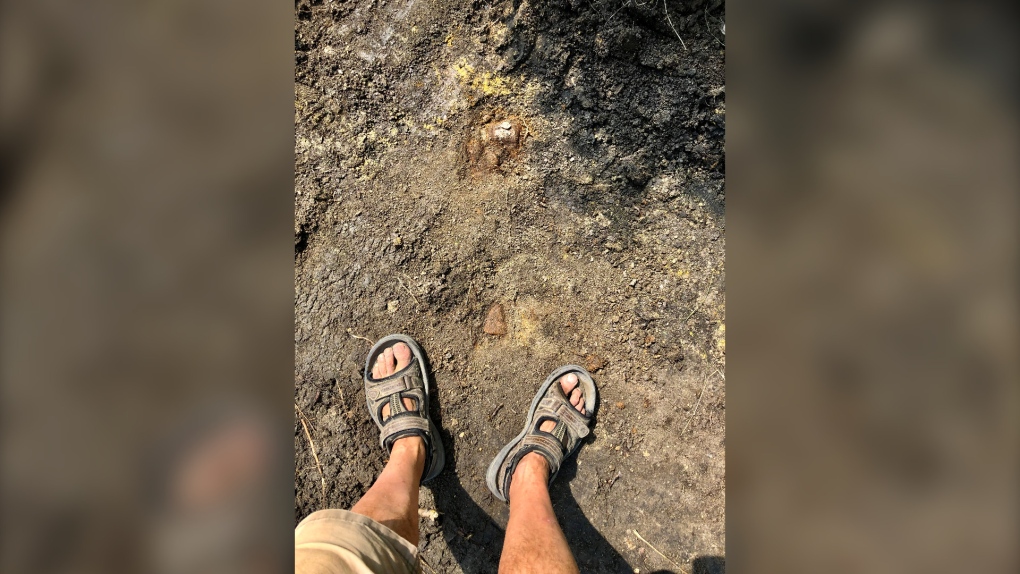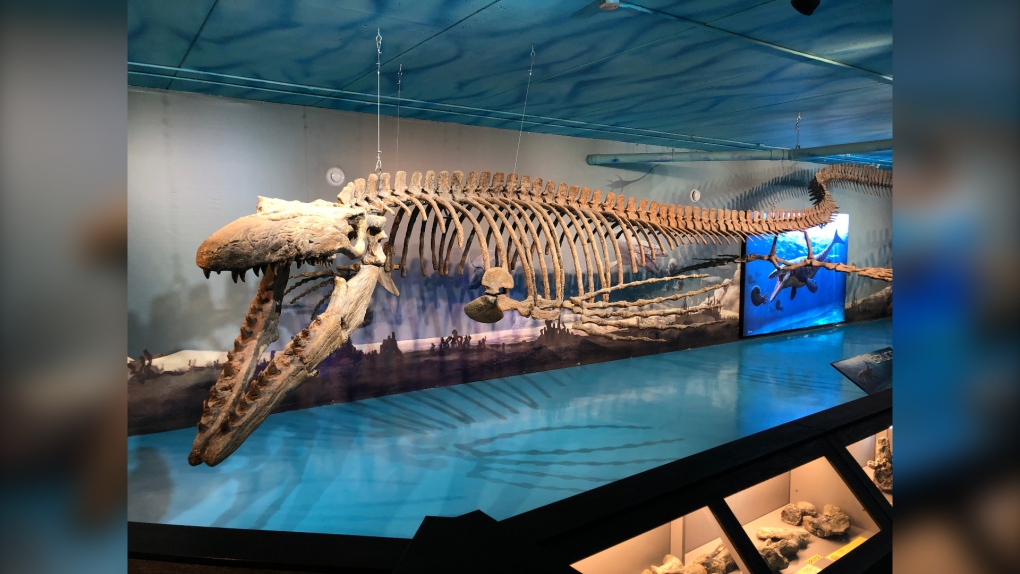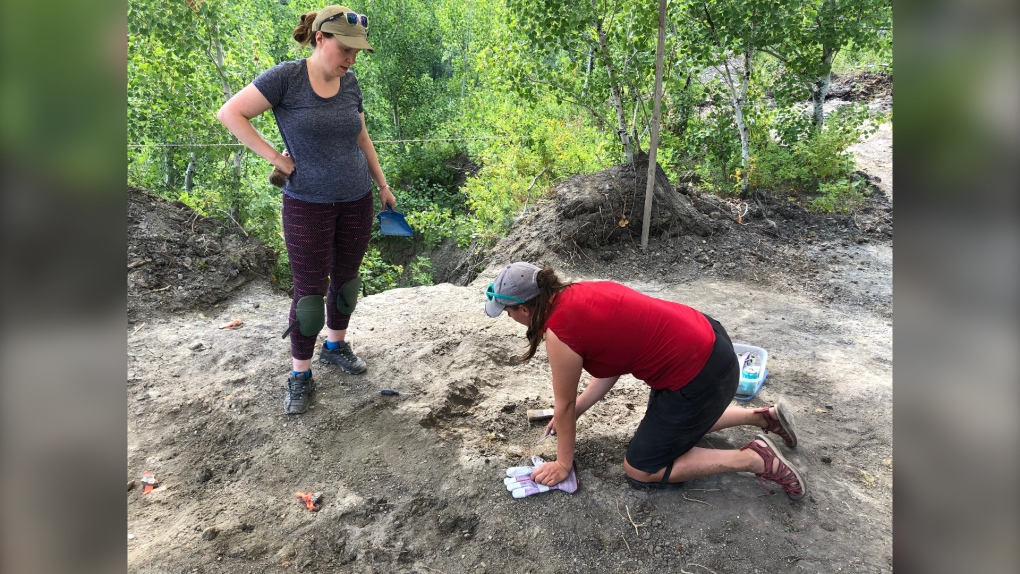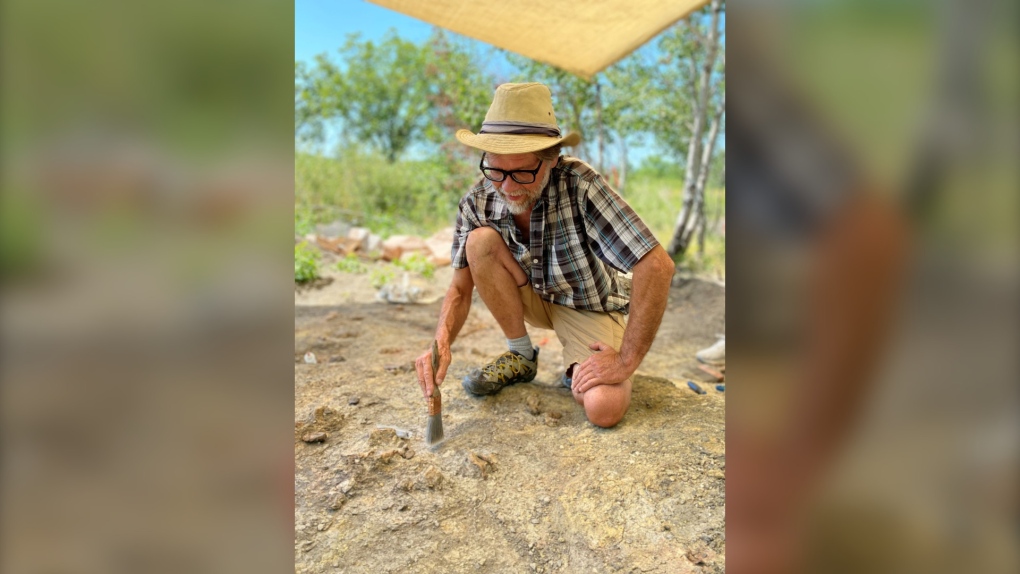After a 10-year drought, two new mosasaurs discovered at Morden fossil centre’s dig site
After a decade-long mosasaur drought in Morden, researchers at the Canadian Fossil Discovery Centre have uncovered not one, but two.
They were discovered weeks apart in June by the centre’s field and laboratory technician Gerry Peters.
The first was found during a systematic search of a wide area Peters guessed would be rich in fossils.
The second was discovered essentially by accident, while Peters was digging a drainage trench with some heavy machinery in an area where fossils were suspected.
“The blade scraped over a fossil, just exposing the top of it, and I saw right away a different colour. Fossils are a slightly different colour than the surrounding rock,” Peters recalled in an interview with CTV News Winnipeg.
 Gerry Peters snapped a photo of the second mosasaur he discovered in June while digging a drainage trench. (Source: Gerry Peters/Canadian Fossil Discovery Centre)
Gerry Peters snapped a photo of the second mosasaur he discovered in June while digging a drainage trench. (Source: Gerry Peters/Canadian Fossil Discovery Centre)
Peters could tell right away it was the vertebrae of a mosasaur, an extinct group of predatory marine lizards that lived during the Cretaceous period about 80 million years ago.
The centre is already home to a Guinness World Record holder for the largest displayed mosasaur named Bruce. He was discovered in 1974, and sprawls through the centre to this day.
But it had been about a decade since the centre had discovered a new mosasaur to add to its collection, let alone two in the span of a few weeks.
 Bruce holds the Guinness World Record for the largest displayed mosasaur. (Source: Canadian Fossil Discovery Centre)
Bruce holds the Guinness World Record for the largest displayed mosasaur. (Source: Canadian Fossil Discovery Centre)
Peters, helped by cascades of museum visitors keen on playing paleontologists for the day, excavated the first mosasaur over the summer, eventually extracting over 300 bones.
With winter coming, Peters planned to hang up his chisel and paintbrush and leave the second mosasaur excavation for the New Year. But spring runoff concerns prompted a fall blitz to excavate the rest of the skeleton.
“We took out the ones that were kind of exposed and in danger of being washed away,” he said.
“We ended up with about three dozen bones, most of them vertebrae or backbones from the tail, really close to the tail, and then at the same time, lots of pieces from the skull, teeth and jaw pieces and that sort of thing.”
The hope is to uncover the rest of the mosasaur next year.
 (Source: Canadian Fossil Discovery Centre)
(Source: Canadian Fossil Discovery Centre)
During the cold months, Peters will begin preparing the bones they’ve excavated in order to be studied and displayed. The whole process could take two to three years.
As for the newest mosasaur names, Peters says they have been referring to them as Baratheon and Stark – a nod to the outlandishly popular book series and television show “Game of Thrones,” but they’re not set in stone yet.
They’re in fitting tradition with Bruce, who gets his named from a Monty Python sketch.
Overall, Peters says the dual discoveries were very exciting.
“Finding a single bone, I do a little jig. This one, I was dancing for most of the day because it’s just so exciting to find what looks to be, more or less, a complete skeleton. It’s really rare.”
 Gerry Peters is seen working on removing dirt around massive mosasaur fossil that was recently discovered in the Morden area. (Aug. 2, 2023. Source: Jon Hendricks/CTV News)
Gerry Peters is seen working on removing dirt around massive mosasaur fossil that was recently discovered in the Morden area. (Aug. 2, 2023. Source: Jon Hendricks/CTV News)
CTVNews.ca Top Stories

BREAKING Donald Trump picks former U.S. congressman Pete Hoekstra as ambassador to Canada
U.S. president-elect Donald Trump has nominated former diplomat and U.S. congressman Pete Hoekstra to be the American ambassador to Canada.
Genetic evidence backs up COVID-19 origin theory that pandemic started in seafood market
A group of researchers say they have more evidence to suggest the COVID-19 pandemic started in a Chinese seafood market where it spread from infected animals to humans. The evidence is laid out in a recent study published in Cell, a scientific journal, nearly five years after the first known COVID-19 outbreak.
This is how much money you need to make to buy a house in Canada's largest cities
The average salary needed to buy a home keeps inching down in cities across Canada, according to the latest data.
'My two daughters were sleeping': London Ont. family in shock after their home riddled with gunfire
A London father and son they’re shocked and confused after their home was riddled with bullets while young children were sleeping inside.
Smuggler arrested with 300 tarantulas strapped to his body
Police in Peru have arrested a man caught trying to leave the country with 320 tarantulas, 110 centipedes and nine bullet ants strapped to his body.
Boissonnault out of cabinet to 'focus on clearing the allegations,' Trudeau announces
Prime Minister Justin Trudeau has announced embattled minister Randy Boissonnault is out of cabinet.
Baby dies after being reported missing in midtown Toronto: police
A four-month-old baby is dead after what Toronto police are calling a “suspicious incident” at a Toronto Community Housing building in the city’s midtown area on Wednesday afternoon.
Sask. woman who refused to provide breath sample did not break the law, court finds
A Saskatchewan woman who refused to provide a breath sample after being stopped by police in Regina did not break the law – as the officer's request was deemed not lawful given the circumstances.
Parole board reverses decision and will allow families of Paul Bernardo's victims to attend upcoming parole hearing in person
The families of the victims of Paul Bernardo will be allowed to attend the serial killer’s upcoming parole hearing in person, the Parole Board of Canada (PBC) says.


































